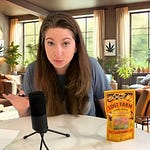Have you ever taken a puff, sat back, and thought, “This doesn’t feel like it used to”? You’re not imagining it—and no, it’s not just age or nostalgia. I recently spoke with Jeff from Jade Nectar, a longtime advocate and cultivator in California’s legacy cannabis scene. What he shared confirms what many of us have quietly suspected: today’s cannabis isn’t the same.
Here are 5 eye-opening truths we uncovered—and why it matters for your health and wellness journey.
1. It’s Not You—It’s the Weed
Remember when a few puffs of a “sativa” would send you into a laughing fit or spark a cleaning spree? These days, even strains labeled “sativa” often leave people feeling foggy, flat, or just… off. Jeff explains that modern commercial cannabis is genetically different from what we once knew.
The old-school highs—bright, psychedelic, joyous—came from unique, often tropical genetics. But today’s buds are bred for appearance and THC numbers, not effect. So if you’ve been wondering why you don’t feel that same magic anymore, you’re not alone—and your endocannabinoid system isn’t broken.
2. True Sativas Are Disappearing—And That’s a Loss
Back in the day, landrace sativas from places like Thailand, Mexico, and Colombia delivered clean, energizing experiences. But they’re a grower’s nightmare: long flowering times, airy buds, and low yields don’t fit today’s industrial model.
So what happened? Big business phased them out. But here’s the kicker: those airy, harder-to-grow flowers are exactly what gave us that spark, that laughter, that clarity.
Let’s be real—the best cannabis for your mind and mood doesn’t come from factory farms.
3. Big Weed Is Failing—Because the Plant Knows
Jeff shared a term that stuck with me: Pragmatic Woo-Woo-ism. It’s the idea that cannabis responds to care. It thrives when it’s grown by people who respect the plant—not by corporations who treat it like corn.
Massive farms using synthetic inputs and chasing THC numbers are hitting a wall. Consumers aren’t feeling the effects, and many of those companies are collapsing. Maybe it’s spiritual. Maybe it’s biological. Maybe it’s both. Either way, the plant isn’t thriving in those environments—and neither are we.
4. The System Was Built to Protect Small Growers—But That Didn’t Happen
When California passed Prop 64, we were promised a wine-country model: small, local farms growing beautiful, intentional cannabis. Instead, we got mega-farms, flooded markets, and prices that crushed the little guys.
The promise of regenerative, artisan cannabis—grown with care, not chemicals—was traded in for a race to the bottom. And now, many of the most experienced, legacy growers are being pushed out of their own industry.
5. There Are Better Options—But We Have to Fight for Them
Between contaminated vape pens, inconsistent testing, and the shrinking availability of quality CBD and medical products, it’s no wonder people are confused. Dispensaries are starting to feel like the junk food aisle of cannabis.
But change is still possible.
Jeff and others are advocating for direct-to-patient medical shipping in California—so folks who rely on cannabis for real wellness can access the products they need, no matter where they live. And every purchase you make—from small, ethical farms and clean cultivators—moves the industry in the right direction.
Final Thought: The Plant Hasn’t Changed—But the System Has
We don’t have to settle for weed that feels empty. We can vote with our dollars, support the growers who care, and demand better. Cannabis has always been a teacher. Maybe now, more than ever, it’s asking us to pay attention.
Special thanks to Jeff from Jade Nectar for sharing decades of insight and passion with us. If you’re looking to reconnect with the cannabis you used to know, start by seeking out clean, intention-grown flower—and never stop asking questions.
Enjoyed this post? Subscribe to our newsletter for daily cannabis wellness insights, reviews, and interviews.
Know someone curious about cannabis today? Share this with them—we’re all learning together.
If my work’s helped you, consider supporting it here—no pressure, just gratitude.
Disclaimer: The information provided on this blog is for educational purposes only and is not a substitute for professional medical advice. Always consult your healthcare provider before starting or changing any treatments, including cannabis use.












Share this post